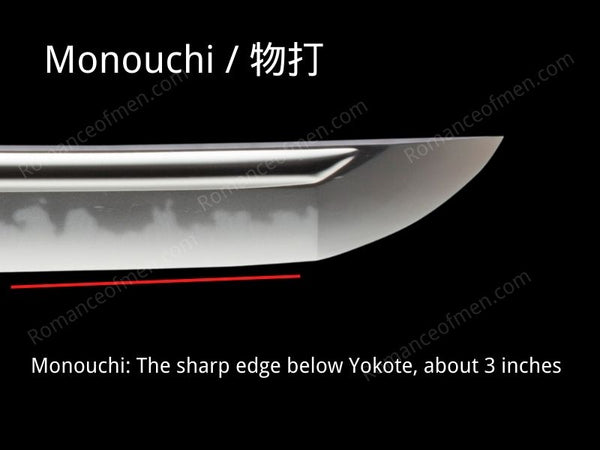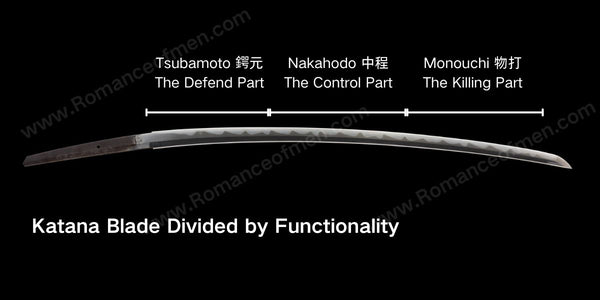Katana Monouchi The hitting part on the sword blade you should know
Complete Guide to Understand Katana Monouchi (物打)

The Katana is a very traditional weapon. If you happen to be a sword enthusiast, then chances are you are aware of the many parts of a typical katana. One of them is Monouchi. So, what is Monouchi in a katana?
Japanese swordsmen, contrary to popular belief, don't "simply" use the entire blade to hit. Each section of the edge is designated to do different things. The Monouchi, is the 'killing region’. Keep reading to find out more!
Table of Content
- What is Monouchi (物打)?
- How to cut with Monouchi in different sword schools
- How To Cut With Katana Correctly?
What is Monouchi (物打)? An Important Part Of The Katana Blade
Functionality speaking, A traditional Japanese sword blade can be divided into three parts. And each has its unique function. Monouchi 物打 is the latter third of the blade, right below the yokote, roughly to the middle of the blade. In traditional Japanese martial arts like Kendo or Iaido, Monouchi is the "Killing zone"
Monouchi is used for hitting targets. As yo can tell from the name 物打 in Japanese, literally means "To hit something". This part is usually the sharpest, the hamon in the area is wider, and during cutting, the force is greatest. Using the "Monouchi" for cutting is a basic principle when you begin to use Japanese swords.
Monouchi (物打), Nakahodo (中程) & Tsubamoto (鍔元) The 3 parts of a katana blade, divided by functionality

Now we know about the Monouchi (物打), we will introduce the other 2 parts.
The lowest part of a blade is the Tsubamoto 鍔元. It’s meant for defending yourself, it's the 防 (Defend) part. It’s the part that’s the closest to the tsuba, hence the name Tsubamoto.
Then we have the middle part of the blade. It's named Nakahodo 中程. This area is also called the sei 制, which can be translated to mean ‘control’. Swordsmen will use different techniques to control enemy sword strikes.
How to cut with Monouchi in different sword schools
Even though all schools of thought agree that the hitting region is the Monouchi, there are some nuanced differences. For example, some schools of thought will hit with the latter third of the Monouchi.
On the other hand, some schools of thought hit with the middle part of the Monouchi. Then some schools hit the lower part of the Monouchi. It's the part that is closest to Nakahodo.
Hitting with the later third or the top of the blade might have some downsides. The blade might not make much contact. And that can inflict less damage.
That doesn't mean it won't severely harm the target, though. A katana blade is very dangerous when wielded by the right person.
Monouchi And Kendo
Kendo is a modern Japanese martial art. It's done with a wooden sword and is also a sport. If you want to visualize where the Monouchi is, you can use a shinai. Shinais are wooden swords made for practice.
The cool thing about it is that the Monouchi will be marked on it. That's how much emphasis swordsmen put into their swords. They always want to hit the right part of the sword when practicing.
This will allow them to deal more damage and keep the sword effective for a longer period of time. However, with a shinai, you shouldn’t hit the tip of the blade. It’s important to hit the middle part of the Monouchi.
How To Cut With Katana Correctly?
Many people don't realize that cutting with the Katana isn't just about swing the blade. There's a particular tactic to it. And which part of the blade you use matters. The correct way to hit with a Japanese sword is with the Monouchi.
There are a couple of reasons for this. The Monouchi is the fastest part of the blade that will contact the target. So, when you're swinging that blade, you want to hit your target first. It isn't the strongest part, however. But if done right, it can do a lot of damage.
When you don't know the right techniques, your cutting might not be as effective as expected. But that might not even be the Katana. It could just be that you’re doing something wrong.
Since you know which part of the blade to hit with, here’s a detailed guide on how it’ll look in practice.
Tip 1: Slice Instead of Hacking
A katana is designed to slice through targets. Inexperienced swordsmen might tend to cut or hack their targets. If you apply enough force and your target is weak, it can be possible to cut. But you won't use your blade efficiently.
So, you should aim for a slicing motion when you’re hitting. Once it makes contact with the target, drag it.
Tip 2: Proper Technique
Technique is everything. It's what differentiates a master swordsman from an amateur one. You should hold the Katana like a golf club. Your dominant hand should be about an inch from the tsuba.
Hold it firmly but also relax your hands. Use your bottom three fingers to grip it tightly. The index finger doesn’t touch the sword much. If you hold it too tight, you'll lose control.
Tip 3: Edge Alignment
The other tips are pointless if your edge alignment isn't good. You can practice edge alignment on newspapers. Suspend newspapers in the air and try to cut them. It'll help you improve your edge alignment.
You can get by with a mediocre grip or low force if your edge alignment is perfect. However, you should try to perfect all three aspects of using the katana blade. It’ll help you become more skilled.
Of course, you shouldn't use a sharp blade alone, especially if you don't have formal training. Katanas shouldn't be used by inexperienced hands.
Wrapping Up
What is Monouchi in a katana good for, then? Well, it serves the main purpose of a blade. This is the part where you hit targets with it. It certainly isn't the strongest part of the blade. But it sure is the fastest.
You'll be a skillful swordsman if you can control the Monouchi, along with the right technique. There are no hard rules on which specific area of the Monouchi is best.
Although, different schools of thought have emerged. Some prefer the later third of the Monouchi – the very tip of the sword. Others prefer hitting with the middle or lower part of the Monouchi. That’s all on the Monouchi. See you next time with another informative article like this one.





















